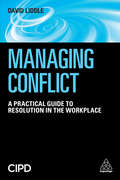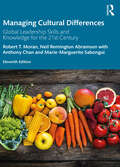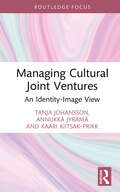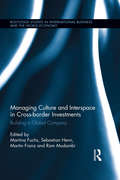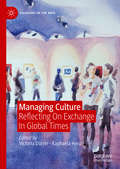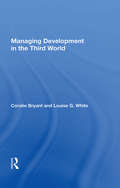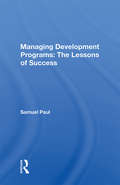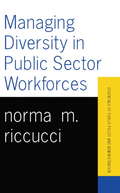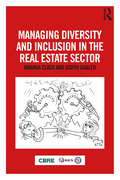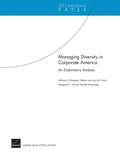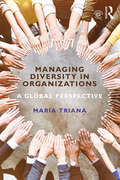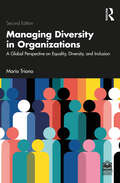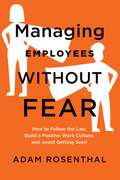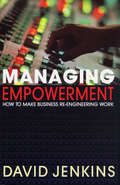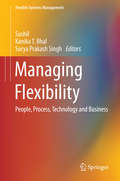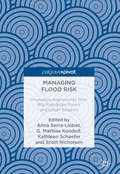- Table View
- List View
Managing Conflict: A Practical Guide to Resolution in the Workplace
by David LiddleConflict in the workplace is a perennial problem for organizations. Whether it's a disagreement between colleagues, a dispute with management or large-scale industrial action, conflict negatively affects both people and profits as employee morale and productivity fall. Managing Conflict is an essential guide for HR professionals needing to tackle these problems by not only resolving current issues but also preventing future instances of conflict. Going beyond interpersonal conflict, the book also looks at resolving board room disputes, disputes with shareholders, in the supply chain, commercial disputes and customer complaints.The first part of Managing Conflict covers the causes and costs of conflict, the impact of the psychological contract and the legal framework for managing workplace disputes both in the UK and internationally. The second part of the book provides a blueprint for redefining resolution and building a culture of constructive conflict management, from designing a conflict management strategy and developing a formal resolution process to embedding mediation, engaging stakeholders and training managers in resolution skills. It also includes conflict resolution toolkits for managers, HR teams, employees and unions to help tackle conflict and bullying at work. Packed with best practice case studies from major UK and global organizations, this is an indispensable guide for all HR professionals looking to resolve conflict in the workplace.
Managing Conflict: A Practical Guide to Resolution in the Workplace
by David LiddleWhether it's a disagreement between colleagues, a dispute with management or large-scale industrial action, conflict at work is a perennial problem for organizations, their people and profits.The second edition of Managing Conflict shows HR professionals how to tackle these problems by not only resolving current issues, but also preventing future instances of conflict. It includes the latest research and case studies showing how conflict management has been impacted by hybrid working models and digitalization. There are also updates to reflect how resolution is a driver of trust in organizations, enabling people to disagree more constructively in a safe environment.This book covers the causes and costs of conflict, the impact of the psychological contract and the legal framework for managing workplace disputes both in the UK and internationally. It shows how to design a conflict management strategy, develop a formal resolution process and engage stakeholders and training managers in resolution and mediation skills. Packed with best practice examples from organizations such as Tesco, Burberry and Nationwide Building Society as well as conflict resolution resources and toolkits, this book is essential reading for all HR professionals looking to resolve conflict in the workplace.
Managing Cultural Differences
by Robert T. Moran Neil R. Abramson Sarah V. MoranThe world of business for all organizations in the twenty-first century is global, interdependent, complex, and rapidly changing. That means sophisticated global leadership skills are required more than ever today. Individual and organizational success is no longer dependent solely on business acumen. Our ability to understand, communicate, and manage across borders, countries, and cultures has never been as important as it is now. The understanding and utilization of cultural differences as a business resource is a key building block as companies rely on their global reach to achieve the best profit and performance. For this reason, international business and cross-cultural management are key topics in undergraduate business, MBA, and executive education programs worldwide as companies and institutions prepare current and future business leaders for the global marketplace. This exciting new edition of the highly successful textbook, Managing Cultural Differences, seeks to guide students and any person with global responsibilities to understand how culture fits in a changing business world, how to gain a competitive advantage from effective cross-cultural management, and gives practical advice for doing business across the globe. With updated content, new case studies, and a new author team, Managing Cultural Differences is required course reading for undergraduates, postgraduates, and MBA students alike, as well as being of significant value for anyone who sells, purchases, travels, or works internationally.
Managing Cultural Differences: Global Leadership Skills and Knowledge for the 21st Century
by Robert T. Moran Neil Remington Abramson Anthony Chan Sabongui Marie-MargueriteIn today’s global business environment, it is vital that individuals and organizations have sophisticated global leadership skills. Communication and understanding of different cultures are paramount to business success. This new edition of the bestselling textbook Managing Cultural Differences guides students and practitioners to an understanding of how to do business internationally, providing practical advice on how competitive advantage can be gained through effective cross-cultural management. The digitization of the workplace, the integration of artificial intelligence into workplace cultures, cultural responses to crisis, and the value of diversity and inclusion are just a few examples of contemporary issues discussed in this text. This latest edition also begins with a completely new introductory chapter, which provides an overview and connects the themes between chapters for an integrated understanding of the topic. With a wealth of new examples, case studies, and online materials, this textbook is required course reading for undergraduates, postgraduates, and MBA students alike, as well as being a vital tool for anybody selling, purchasing, traveling, or working internationally.
Managing Cultural Differences: Global Leadership for the 21st Century (Managing Cultural Differences Ser.)
by Robert T. Moran Neil Remington AbramsonIn today’s global business environment, it is vital that individuals and organizations have sophisticated global leadership skills. Communication and understanding of different cultures is paramount to business success. This new edition of the bestselling textbook, Managing Cultural Differences, guides students and practitioners to an understanding of how to do business internationally, providing practical advice on how competitive advantage can be gained through effective cross-cultural management. Crises in the Middle East, the weakening of some emerging markets, and the value of diversity and inclusion are just a few examples of contemporary issues discussed in this text, which also introduces a completely new chapter on global business ethics. With a wealth of new examples, case studies, and online materials, this textbook is required course reading for undergraduates, postgraduates, and MBA students alike, as well as being a vital tool for anybody selling, purchasing, traveling, or working internationally.
Managing Cultural Joint Ventures: An Identity-Image View (Routledge Research in the Creative and Cultural Industries)
by Tanja Johansson Annukka Jyrämä Kaari Kiitsak-PrikkThis book provides an in-depth exploration of two key aspects of managing cultural collaborations: managing the multiple identities of venture participants and managing the diverse images and brand relationships. There are a variety of books available on mergers and acquisitions in the corporate world, but cultural joint ventures have not been examined in detail, and there are significant differences to consider. Cultural joint ventures are emerging as an important organizational structure in the creative sector. This is largely due to uncertainties in public funding, increased competition for audiences, and the ongoing search for innovative programming. Although arts organizations need to understand and manage these economic aspects, other aspects including internal culture, identity, and brand image are vital to the successful management of cultural joint ventures. Taking a global view and covering a variety of creative collaborations, the authors present case studies from Scandinavia, Europe, North and South America, and New Zealand. From a managerial point of view, this book is valuable not only for a range of managers working in different types of cultural centres but also for managers working within various collaborative efforts in the creative industries more broadly. This will also be a valuable resource for researchers and scholars in the fields of arts management and marketing.
Managing Culture and Interspace in Cross-border Investments: Building a Global Company (Routledge Studies in International Business and the World Economy)
by Martina Fuchs Sebastian Henn Martin Franz Ram MudambiThis book focuses on the dialectics between spatio-organisational gaps and local contexts that characterise cross-border investments. "Interspatial" investments – be it mergers & acquisitions (M&A) or greenfield investments – are usually characterised by what is referred to as "otherness", i.e. organisational and cultural distances of the firms involved in relation to their regional contexts. At the same time, economic, political and socio-cultural linkages are decisive for attracting cross-border investments to regions and for providing firms with conditions supportive of their market success. As a consequence of being locked into complex structures of proximities, cross-border investments are situated in contested terrain. This terrain triggers learning processes in both regional actors and investors, which can result in the convergence of mindsets and organisational issues. This book is unique in that it combines interspace (defined as the distance between the new owner and the cross-border venture), place (the target region), interpretation (perception and understanding of the investment by the actors involved) and context (institutions, actor networks and interaction), thus offering better understanding of recent processes of globalisation. Crossing disciplinary boundaries by integrating economic geography and management studies, the volume adopts an innovative and spatially informed perspective on foreign direct investments (FDI). This perspective will be of great value to scholars, students and practitioners. The volume is inventive in its approach in that it offers fresh readings from interdisciplinary theoretical approaches and combines these with valuable empirical insights from developed as well as Emerging Economies.
Managing Culture: Reflecting On Exchange In Global Times (Sociology of the Arts)
by Raphaela Henze Victoria DurrerThis book provides new insights into the relationship of the field of arts and cultural management and cultural rights on a global scale.Globalisation and internationalisation have facilitated new forms for exchange between individuals, professions, groups, localities and nations in arts and cultural management. Such exchanges take place through the devising, programming, exhibition, staging, marketing, and administration of project activities. They also take place through teaching and learning within higher education and cultural institutions, which are now internationalised practices themselves. With a focus on the fine, visual and performing arts, the book positions arts and cultural management educators and practitioners as active agents whose decisions, actions and interactions represent how we, as a society, approach, relate to, and understand ourselves and others. This consideration of education and practice as socialisation processes with global, political and social implications will be an invaluable resource to academics, practitioners and students engaging in arts and cultural management, cultural policy, cultural sociology, global and postcolonial studies.
Managing Death
by James M. HoeflerMany Americans, before they die, will go through a stage where they are unable to make competent decisions about their own life-sustaining medical treatment. More and more, family members and care givers are facing these difficult decisions in their stead, becoming engulfed in questions about personal wishes, medical ethics, state and federal law, and quality of life. Drawing on provocative case studies, personal interviews, and detailed research, James Hoefler examines the medical, legal, ethical, and clinical aspects of such right-to-die issues. Beginning with the legal struggle of a woman whose son existed in a persistent vegetative state (PVS) for seventeen years, the author moves into a broader look at consensus among professional organizations, from the AMA to the President's Commission to the National Center for State Courts; beliefs of mainstream religious groups; public opinion; issues surrounding end-stage Alzheimer's and other organic brain disorders that can slowly lead to PVS; and the role of artificial nutrition and hydration in these cases. Hoefler concludes with recommendations on how to improve the quality of right-to-die decision making. An absorbing read with a minimum of technical jargon, this book is a valuable guide to care givers, public policy students, medical ethicists, family members, and anyone facing questions about an individual's right to die.
Managing Death: International Perspectives
by Neil Thompson Gerry R. CoxThere is a huge collection of literature relating to death, grief and bereavement, but one aspect that has received relatively little attention is that of death management practices (by which we mean the various ways of managing the circumstances of the death, ritually acknowledging it and sensitively handling the disposal of the body and so on). While ways of disposing of the dead and grief practices have been thought of as based upon individual responses, grief and bereavement practices can be understood not only by looking at psychological and medical frameworks, but also by examining people as part of a complex structure of social arrangements, institutions, structures, and patterns. By examining the social and institutional structures of various groups around the world, we provide an international framework for a better understanding of the study of dying, death, and bereavement.This book highlights the significance of these matters in an international context, reflecting common themes and important differences. It will highlight common themes across diverse cultures and national settings, while also drawing attention to significant differences. If professionals working in the field of death, grief and bereavement are not aware of such differences, their practice can be insensitive, discriminatory and therefore ineffective, if not actually counterproductive. As such, the book provides an invaluable resource for a wide variety of professionals and students, including medicine and health care; social work; counselling and psychotherapy; chaplaincy and pastoral work; and, of course, those involved in the funeral industry. In addition, students of sociology, psychology and anthropology will find much of interest here in terms of appreciating the diversity of ways in which funerals and other death management practices are managed and integrated into social life.
Managing Decline: A Research Overview (State of the Art in Business Research)
by Juha-Antti Lamberg Antti Sihvonen Henrikki TikkanenA growing body of literature in the area of business administration has focused on the phenomenon of decline. These studies span multiple levels of analysis and draws on a range of disciplines, including strategic management, economics, and economic geography. Managing Decline: A Research Overview provides a summary of this research by focusing on three key levels of analysis: industries, clusters, and organizations. The targeted reviews in this book map each individual level of analysis separately and the discussion section outlines overarching themes regarding decline and its management. The three levels are analyzed by identifying different forms, causes, processes, and management options regarding decline. This is accompanied by the identification of key academic discourses that have been used to analyze decline. The discussion section highlights broader themes regarding the nature and management of decline that span across the different levels of analysis. This book provides an easy-to-access summary on the nature and management of decline for academic scholars and business practitioners, and is essential reading for getting an overview of this broad field of research.
Managing Development In The Third World
by Coralie BryantThis is the first text to focus on the problems and processes involved in organizing, implementing, and managing programs and projects aimed at relieving poverty and underdevelopment in the Third World. During the 1970s there was a shift in development assistance programs toward a greater concern for equity and the basic needs of the poor. The auth
Managing Development Programs: The Lessons Of Success
by Samuel PaulThis book explores a neglected dimension - the role of management interventions in development programs. It investigates two basic questions: what are the management and institutional interventions associated with successful development programs? what lessons can we learn from their experience?
Managing Digital Transformation: Understanding the Strategic Process
by Andreas HinterhuberThis book provides practising executives and academics with the theories and best practices to plan and implement the digital transformation successfully. Key benefits: an overview on how leading companies plan and implement digital transformation interviews with chief executive officers and chief digital officers of leading companies – Bulgari, Deutsche Bahn, Henkel, Lanxess, L’Oréal, Unilever, Thales and others – explore lessons learnt and roadmaps to successful implementation research and case studies on the digitalization of small and medium-sized companies cutting-edge academic research on business models, organizational capabilities and performance implications of the digital transformation tools and insights into how to overcome internal resistance, build digital capabilities, align the organization, develop the ecosystem and create customer value to implement digital strategies that increase profits Managing Digital Transformation is unique in its approach, combining rigorous academic theory with practical insights and contributions from companies that are, according to leading academic thinkers, at the forefront of global best practice in the digital transformation. It is a recommended reading both for practitioners looking to implement digital strategies within their own organisations, as well as for academics and postgraduate students studying digital transformation, strategy and marketing.
Managing Diversity In Public Sector Workforces
by Norma RiccucciAs we enter the twenty-first century, America’s workforce looks markedly different than it ever has before. Compared with even twenty years ago, more white women, people of color, disabled persons, new and recent immigrants, gays and lesbians, and intergenerational mixes now work in America. The way in which government employers embrace this opportunity of diversity will clearly distinguish effective and efficient organizations from those which are unproductive and unable to meet the demands and necessities of the American people in the new century. This book addresses the demographic changes to the labor force and workplace and the ways in which government employers are managing the imminently diverse populations that now fill public sector jobs. It addresses the specific management strategies and initiatives relied upon by public sector employers as well as the implications of effectively managing variegated workforces for the overall governance of American society.
Managing Diversity and Inclusion in the Real Estate Sector
by Amanda Clack Judith GablerResearch shows that high-performing organisations focus on diversity and inclusion (D&I). In any workplace, it is important to both understand and recognise the benefits that having a D&I workforce provides. It is integral to developing people within an organisation, serving clients as best we can, and playing an important leadership role in communities. This book is the first to place D&I at the centre of successful real estate and construction organisations. It provides guidance to, and most importantly, actions for professionals in the sector who want to make D&I an inherent part of the culture of their organisation. This book has been written to bring the sector up to speed with what D&I is all about and how a D&I strategy can be implemented to secure future success. It presents a practical and easy-to-read guide that can help organisations and their leaders engage with and apply this agenda to win the war for talent in real estate and construction. This book is essential reading for all property leaders and professionals working in the real estate and construction sectors. Readers will gain especially from personal reflections on all aspects of diversity by a broad range of people working in the property industry.
Managing Diversity in Corporate America: An Exploratory Analysis
by Margaret C. Harrell Jefferson P. Marquis Nelson Lim Jennifer Erin Kavanagh Lynn M. ScottDevelops a fact-based approach to modeling diversity management in U.S. corporations, analyzes the strategies pursued by 14 large U.S. companies recognized for their diversity or human resource achievements, and compares a number of company characteristics. Firms recognized for diversity are distinguished by a core set of motives and practices, but best practices per se may not enable a company to achieve a high level of diversity.
Managing Diversity in Organizations: A Global Perspective
by María TrianaThis book equips students with a thorough understanding of the advantages and challenges presented by workplace diversity, suggesting techniques to manage diversity effectively and maximize its benefits. Readers will learn to work with diverse groups to create a productive organization in which everyone feels included. The author offers a comprehensive survey of demographic groups and an analysis of their history, allowing students to develop a deep understanding of the dimensions of diversity. From this foundation, students are taught to manage diversity effectively on the basis of race, sex, LGBTQIA, religion, age, ability, national origin, and intersectionality in organizations and to understand the issues various groups face, including discrimination. Opening with current case studies and discussion questions to enhance comprehension, the chapters provide practical insight into subconscious/implicit bias, team diversity, and diversity management in the United States and abroad. "Global View" examples further highlight how diversity management unfolds around the world. Offering a fresh look at workplace diversity, this book will serve students of diversity, human resource management, and organizational studies. A companion website featuring an instructor’s manual, PowerPoint slides, and test banks provides additional support for students and instructors.
Managing Diversity in Organizations: A Global Perspective on Equality, Diversity, and Inclusion
by María TrianaManaging Diversity in Organizations equips students with a thorough understanding of the advantages and challenges presented by workplace diversity, suggesting techniques to manage diversity effectively, maximize its benefits, and build more inclusive organizations. Readers will learn to work with diverse groups to create a productive organization in which everyone feels included.The author of this book offers a comprehensive survey of demographic groups and an analysis of their history, allowing students to develop a deep understanding of the dimensions of diversity. From this foundation, students are taught to manage diversity effectively on the basis of race, sex, LGBTQIA+, religion, age, ability, national origin, and intersectionality in organizations and to understand the issues various groups face, including discrimination. Opening with current case studies and discussion questions to enhance comprehension, the chapters provide practical insight into subconscious/implicit bias, team diversity, and diversity management in the United States and abroad. “Global View” examples further highlight how diversity management unfolds around the world. Now in its second edition, this popular text has been thoroughly revised and updated with new cases throughout. It also includes an expanded chapter on intersectionality to cover the advancements in this area, as well as more coverage of inclusion, mindfulness, and mental health and well-being as practices that can contribute toward diversity and inclusion in workspaces.Offering a fresh look at workplace diversity, this book will serve students of diversity, human resource management, and organizational studies.
Managing Emergent Phenomena: Nonlinear Dynamics in Work Organizations
by Stephen J. GuastelloChaos, catastrophe, self-organization, and complexity theories (nonlinear dynamics) now have practical and measurable roles in the functioning of work organizations. Managing Emergent Phenomena begins by describing how the concept of an organization has changed from a bureaucracy, to a humanistic and organic system, to a complex adaptive system. The dynamics concepts are then explained along with the most recent research methods for analyzing real data. Applications include: work motivation, personnel selection and turnover, creative thinking by individuals and groups, the development of social networks, coordination in work groups, the emergence of leaders, work performance in organizational hierarchies, economic problems that are relevant to organizations, techniques for predicting the future, and emergency management. Each application begins with a tight summary of standard thinking on a subject, followed by the new insights that are afforded by nonlinear dynamics and the empirical data supporting those ideas. Unusual concepts are also encountered, such as the organizational unconscious, collective intelligence, and the revolt of the slaved variables. The net results are a new perspective on what is really important in organizational life, original insights on familiar experiences, and some clear signposts for the next generation of nonlinear social scientists.
Managing Employee Burnout: How to Develop A Happy, Healthy and Engaged Workforce
by Shauna MoranBurnout is a state of emotional, physical and mental exhaustion. In the workforce, it leads to higher levels of stress, greater sickness absence, sluggish productivity and increased staff turnover so addressing this is urgent.Managing Employee Burnout covers everything from what burnout is, what causes it and what different forms it can take. It also explores the role of the organization in employee burnout and includes specific guidance on how to manage burnout in remote and hybrid working environments and why dispersed teams may be more susceptible to burnout. Full of actionable advice and real world examples, this book demonstrates what strategies to put in place to safeguard staff retention and productivity from burnout as well as how to promote awareness and emotional intelligence in the business. This book also explains why effective company culture, communication, leadership and an inclusive talent strategy are key to building a healthy, engaged and sustainable workforce. There is also coverage of how to improve employees' mental health and discussion of the importance of taking a break and how to establish healthy boundaries. Managing Employee Burnout is crucial reading for all HR professionals and all those responsible for talent management who are looking to ensure a healthy, happy and productive workforce.
Managing Employees Without Fear: How to Follow the Law, Build a Positive Work Culture, and Avoid Getting Sued
by Adam RosenthalManaging people is rewarding, but it can be risky without the right guidance. Managing Employees Without Fear is a comprehensive, practical guide for managers seeking to lead teams effectively while complying with employment laws. Workplace attorney Adam Rosenthal walks readers through the full employee lifecycle, from hiring and onboarding to discipline, performance reviews and terminations. The book covers essential topics such as harassment prevention, implicit bias, managing remote workers and having difficult conversations, all presented in a clear, step-by-step format.Packed with real-world insights and practical tools, this is an indispensable resource for managers who want to lead with confidence, fairness and compliance.
Managing Empowerment
by David JenkinsMany senior managers are faced with the decision as to whether or not they should 'go' for empowerment. Their major concern is the likely effect of empowerment on mangers, supervisors, and the organisation as a whole. Empowerment has the capacity to bring about major changes in the roles of every key player, and ultimately leads to the emergence of a new organisation. This book examines the implications for empowerment at every level, including such issues as training, career paths, company communications and the ability to respond to the demands of the market place. It is supported by plentiful case study material, much of it drawn from the author's own experience.
Managing Flexibility
by Sushil Kanika T. Bhal Surya Prakash SinghThis edited book provides a conceptual framework of managing flexibility in the areas of people, process, technology and business supported by researches/case applications in various types of flexibilities in business. The book is organized into following five parts: (i) Managing Flexibility; (ii) People Flexibility; (iii) Process Flexibility; (iv) Flexibility in Technology and Innovation Management; and (v) Business Flexibility. Managing flexibility at the level of people, process, technology and business encompasses the requirements of both choice and speed. The need for managing flexibility is growing to cope with the developments and challenges in the global business environment. This can be seen from reactive as well as proactive perspectives. Flexibility is a major dimension of business excellence and deals with a paradoxical view point such as stability and dynamism, continuity and change, centralization and decentralization, and so on. It needs to be managed at the levels of people, process, technology and various business functions and it is important to create flexibility at the level of people to create and manage flexibility in processes and technologies in order to support flexible business requirements.
Managing Flood Risk: Innovative Approaches From Big Floodplain Rivers And Urban Streams
by Scott Nicholson G. Mathias Kondolf Anna Serra-Llobet Kathleen SchaeferThe past half century has seen an evolution in thinking from ‘flood control’ to ‘flood risk management’, recognizing that risk results from both hazard and vulnerability. Rather than rely only on engineering structures to reduce flood magnitude or extent, recent policies emphasize avoiding construction in flood-prone areas (or moving people from floodplains), reducing impacts on exposed populations through early warning systems, and insurance to aid in recovery. Implementing this new approach faces many challenges but also offers opportunities for synergies, as described in this book for a range of large floodplain rivers and smaller urban streams across North America and Europe. This book is unique in presenting the voices of those on the front lines of implementing a new paradigm in flood risk management, each river with a unique set of challenges and opportunities derived from its specific geography as well as differences in governance between the American and European contexts.
